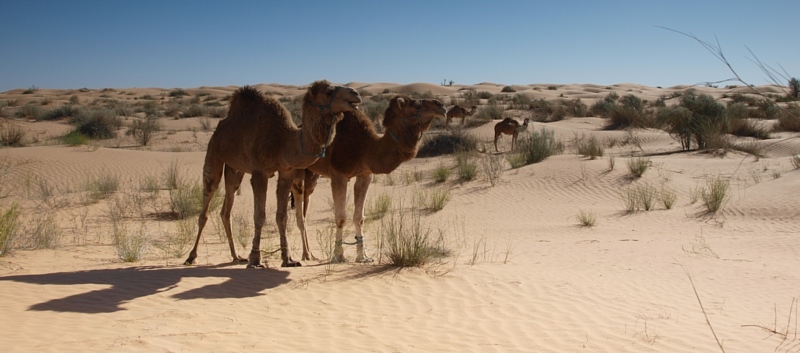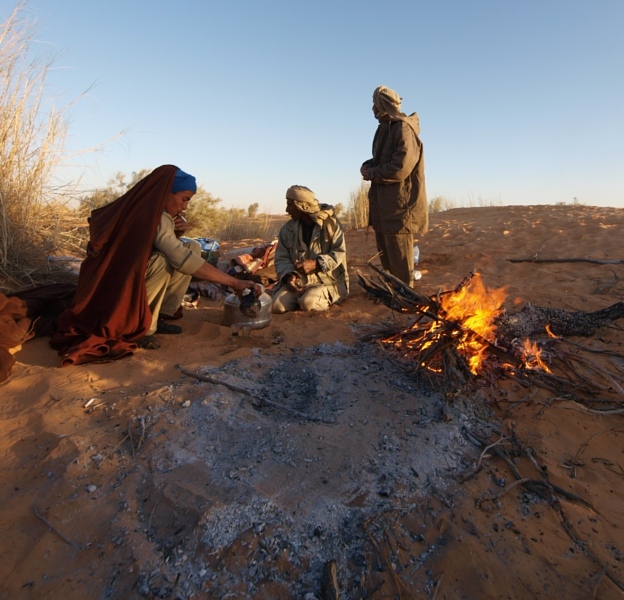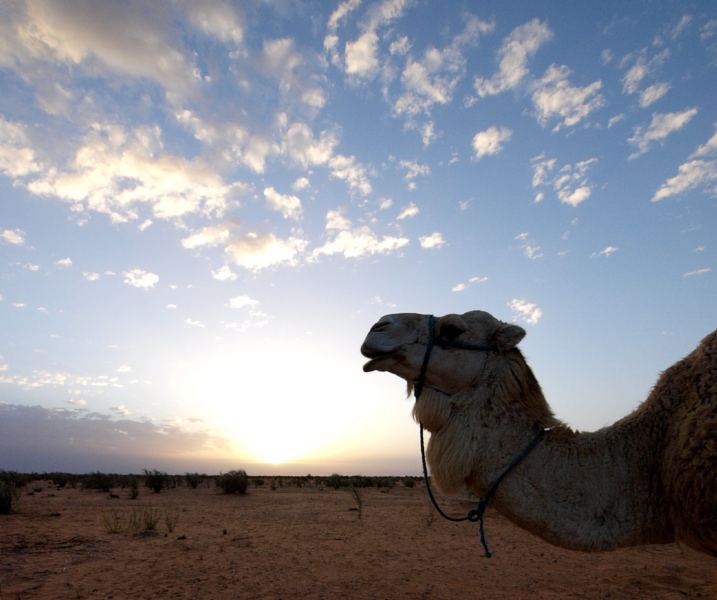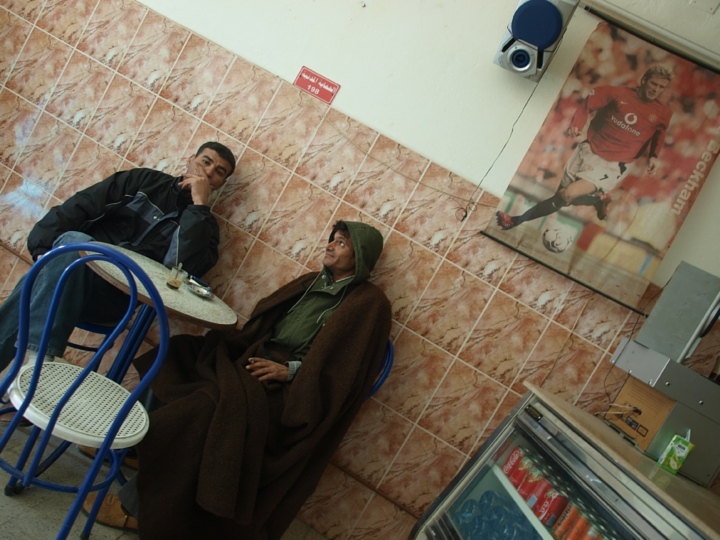|
Introduction:
This UKPSG user field report/review describes my experience with the Olympus E-3 camera and various accessories, during a short trip to the Tunisian Sahara (Eastern Grand Erg).
Expect no professional opinion: I am by no means a professional (or not even a very experienced) photographer. My interest in photography was very basic, until little over a year ago. I always enjoyed making family and holiday snapshots with various cameras (both analog and digital, but all of them Olympus), and tried my best at composition, but wasn't concerned with post-processing or any other setting than *full auto*.
In 2007 I wanted to explore photography further, and bought the E-330 with two kit lenses, which proved to be the beginning of a mild obsession (ask my wife!). Soon, a modest collection of lenses accumulated in my bag(s).
I resisted buying the E-3 for a short while, but ultimately bought it, mainly because of the prospect of a couple of travels this year, in which the camera's ruggedness and weatherproofing would be valuable.
|
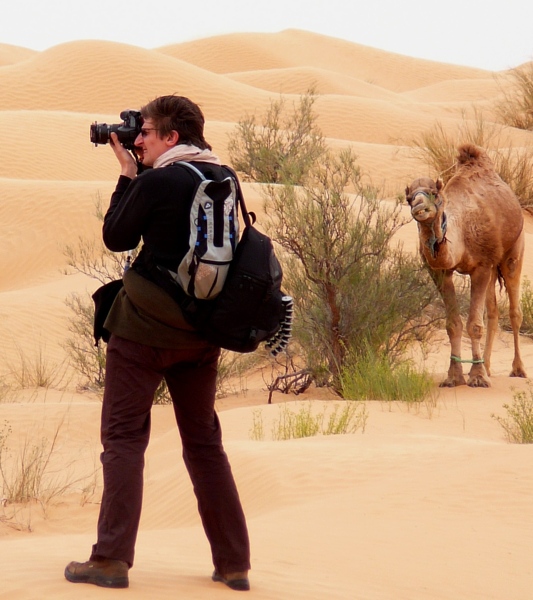
"That's me, with water bag and camera gear."
[credit for this picture: Joelle C or Marc VB, not with E-3, but their own camera]
|
|
The trip and circumstances:
Our Sahara trip was not a solo enterprise, but rather a trip organized by the Social Events committee of the Antwerp Bar, of which my wife and I are members. About 50 persons participated in this adventure, that proved to be quite challenging, but all the more inspiring. For many of us, it was an unforgettable and exhilarating experience that will surely be repeated in years to come.
A Tunisair flight on Tuesday March 4 took us to Djerba, from which a convoy of ten 4WD vehicles took us the same day through the mountains and to the edge of the Eastern Grand Erg (eastern Sahara sand desert). The first night was spent in a base camp where there were still limited sanitary and electrical facilities (and some "touristy" entertainment).
|

"Base camp at the edge of the desert"
|
|
The next three days, we wandered through the Desert, in a succession of bare sand dunes and stretches of sparse vegetation, accompanied by a crew of 1 competent and friendly French expedition leader and 10 Bedouins.
Walking was on foot, with just a few of the crew with three dromedaries accompanying the group and carrying some food and water, while the rest of the crew speed-marched about 25 other dromedaries to our next campsite, carrying the Bedouin tents in which we were to sleep, kitchen utensils and supplies. They also took all of our luggage (except for personal matters that everyone carried in their own backpacks; for me this was limited to some water and my camera equipment).
Each day, after about 4 to 5 hours walking, we reached the agreed spot for our next camp (usually in an area with some vegetation and dry deadwood for the fire), where a simple cold lunch was taken. In the afternoon, the campsite and diner was prepared by our Bedouin fellows and anyone not interested in more walking. While the dromedaries looked for food, the group took another long walk, sometimes encountering herds of sheep or goats.
After sunset, the equally simple evening meal was taken around the campfire, followed by some singing, story-telling and puzzles or guessing games for those interested. The night was spent in the open-ended Bedouin tents (or just out in the open under the stars, like we did), while the dromedaries rested immediately around us.
|

"Waking up after a cold night under the stars "
|
|
The contacts with the local guys of our crew were just amazing : they proved to be wonderfully open, friendly and generous people who were very glad to share with us some aspects of their life and traditions (like how to rig a tent or load a dromedary, or bake bread in the embers of a small fire). They also welcomed every opportunity to talk, with their varied degrees of skill in French, and us picking up some Arab words. Their company contributed as much to the wonderful experience, as did the landscapes and circumstances.
The weather was not really what you would expect for a walk in the Sahara. On the first day, the weather was quite cold, with harsh winds and rain in the afternoon. On the second day, winds were even harder and accumulated into a mild sandstorm. On the third day, we woke up with humidity and ice on the edges of our sleeping bags, but finally enjoyed an open and sunny day. On this final day all of us (tourists, crew and all animals) walked together in a caravan to meet the cars : truly a sight to behold.
|
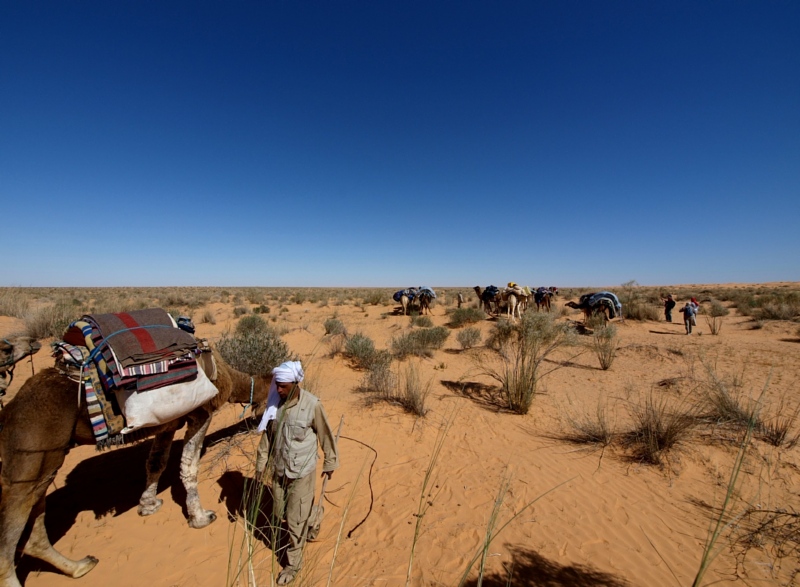
"Our caravan crossing the desert"
|
|
This third day of walking brought us into the Oasis and shanty town of Ksar Ghilane, where we said goodbye to our new friends, and from where we returned to Djerba by 4WD cars through mountainous terrain with troglodyte dwellings and the occasional village, passing also through the City of Medenine.
We made a brief stop in the Soukhs (a real tourist trap and anticlimax after the wonderfully pure experiences in the desert). We spent the final evening and short night in the luxury of a Hotel with Spa, before taking a very early flight back home on Saturday March 8.
|
|
Camera gear taken:
All of my carry-on luggage (and also everything I was able to carry during our walks, apart from a bag of water) consisted of photographic gear, carried in a Lowepro Slingshot 200 AW (see picture).
|
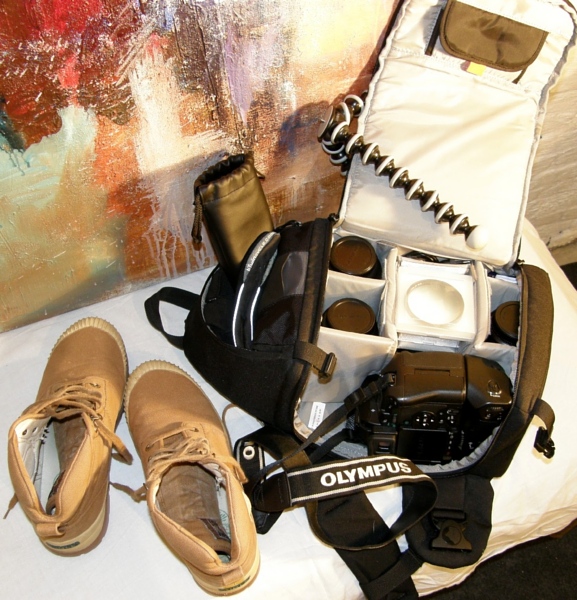
"Lowepro Slingshot 200 holding all my gear for the trip "
|
|
I almost always carried my camera over my left shoulder, pointing backwards and neck strap secured under a strap of my backpack, while the Slingshot obviously went over my right shoulder, thus distributing weight. Underneath the Slingshot on my back was another small backpack with basically only a water bag (MTB type bag).
Configuration of the inside of my Slingshot was fairly obvious :
** The E-3 is accessible via the side zipper.
** You can see, sitting snugly in their slots, the lenses I took : the ZD 50mm, ZD 7-14mm, ZD 14-54mm and ZD 40-150mm (old version kit lens). My most recent acquisition, the ZD 7-14mm, is mounted on the E-3 in this shot, but can also fit in the bottom lens slot if another lens is on the camera. Only when the ZD 50mm is mounted, does the whole package not fit in the bag.
** The FL36 flash is stored in the top compartment, with my gloves and some filters.
** Other small accessories (cards, batteries, remote) are in the front compartment, with the Gorillapod dangling from a strap on the front, curled to fit tightly against the bag.
I had decided not to take a spare body. Limited for weight and space, I preferred to use the room for an extra lens. Moreover, my E-330 wouldn't be weatherproof anyway. I took a gamble in trusting that the E-3 would see me through without need for a backup, and it did brilliantly.
There were a couple of occasions where I wish I had also taken my Olympus SP560UZ (to have a big zoom, if only for use in broad daylight), but in the end it is probably good that I didn't : some other participants' P&S cameras did not survive the dust and weather conditions.
|
|
Experiences with the camera itself:
Let me start by saying that the E-3 really lived up to its reputation and to expectations, where ruggedness, weatherproofing and dustproofing are concerned.
The "Lonely Planet" guide for Tunisia advises (on page 248):
"Cameras and watches should be kept wrapped in plastic bags, to protect them from the very fine Saharan sand that gets into everything."
This is no overstatement. No amount of buttons, zippers or seams could keep out that very fine red sand that is fit so serve in an hourglass. In our days in the desert we suffered humidity, rain, dryness and heavy winds. The sand (both wet and dry) managed to get inside clothes, backpacks and everything, but not inside the E-3.
|
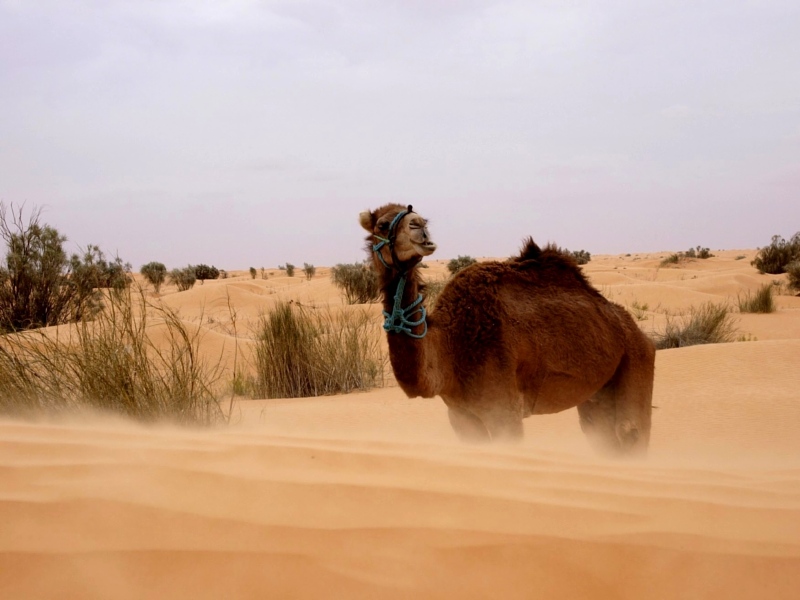
"The modest beginning of a minor sandstorm"
|
|
All the camera's nooks and crannies and rubber seals were absolutely clotted with wet sand and fine dust, but none got inside. And if any did (maybe during frequent lens changes), I didn't notice, so the SSWF dustbuster probably took care of it. No dust shows up in my pictures and the camera showed not a single glitch.
One could argue that I should have taken some extra equipment to take care of my camera better (like a lenspen cleaner and/or a rocket blower), but I did not miss them, and besides, there was never any dust-free cleaning environment anywhere anyhow.
Not having that kind of equipment, I managed to keep most of the sand off my camera by blowing hard, using a microfiber cloth and stuff found in nature. I have learned that taking a small branch or a hard grass-leaf and splitting it into finer parts, is very useful to get to sand clotted in tight spots and thus serve as a disposable substitute for a fine brush.
For those interested, I can say that the parts that suffered most from the dust, were those that you would indeed expect :
** the pop-up flash got clotted pretty badly, up to the point where opening it, resulted not in much "pop" nor "snap" anymore, but in all the more "crackle"... (but it turned out OK after a good thorough clean);
** the LCD hinges became a little crackly too, but functioned perfectly;
** the rubber seals of the card door and battery compartment proved to be effective : upon opening you could see dust sticking onto the seals but not getting any further;
** dust also settled under the dial wheels : after cleaning with a small leaf or branch, the remaining sand could be removed by turning the dial vigorously in all directions.
|

"Desert landscape"
|
|
This trip was the first time I ever used a battery grip on any camera. I didn't notice much difference on the aspect of energy management. To be on the safe side, I had taken 4 BLM1's and that was plenty. I returned with a little above 800 pictures (in essentially 4 days), and have no specific idea how many I deleted along the way. I probably shot around 1000-1200 shots and think I could have made many more if I wanted to.
In order to save on energy I followed a few simple rules :
** I made limited use of Live View.
** I limited chimping, although obviously there were times when fellow-travellers wanted to see what I had shot so far. During the walks, I kept my LCD often turned inwards, also for protection against the torture of lashing sand particles in strong wind and bumping into other people etc. The top LCD was sufficient to check on settings and make adjustments.
** I kept the main LCD brightness not on auto, but reduced to -3 : there was limited looking during the day anyway and that brightness was sufficient at night.
** I used the pop-up flash sparingly.
In the evening I usually mounted the FL-36 flash, not only for some mild flash, but also for its focus assist capabilities with the red grid lights, that are much better and especially less intrusive than the camera's strobing white light. This allowed me to make campfire shots where hardly anybody noticed I was shooting.
|
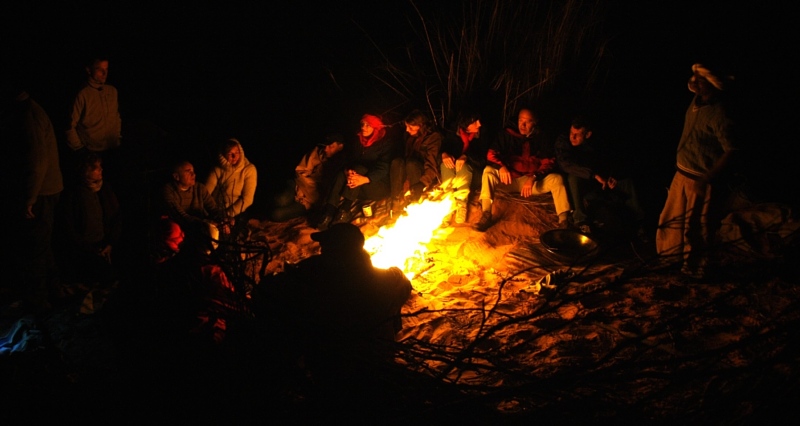
"An evening around the fire. Image Stabilisation is better than flash "
|
|
The cold desert nights did have an effect on the batteries. A camera left in the open at night, showed a drained battery in the morning. After replacing the batteries, I gently reheated them with body warmth in my trouser pocket. I swapped them again, just to check for this report, and noticed that they would be good for another set of shots.
The main result of having the battery grip was that I have taken significantly more pictures in portrait orientation than I would normally shoot. Normally I would guess that my ratio would be about 75 % landscape and 25 % portrait; but from this trip I returned with about a 50/50 distribution of shots.
|

"One of our guides returning from a look-out on top of a dune"
|
|
Lenses and some other photographic accessories:
I have already indicated which lenses I have taken with me. Let me give you a brief and approximate (not at all scientific) idea of percentages of use.
The ZD 14-54mm saw about 50-60 % use, during the day mostly equipped with a filter holder and at night for all general situations where that zoom range proved once again to be most useful.
On the day before leaving, I decided to get a Cokin P Series filter holder for my ZD 14-54mm, along with an ND Grad filter. That turned out to be a very wise last-minute decision. Although the square Cokin filters are veritable dust-magnets, the system and the ND Grad make it easy to adjust exposure for landscapes, no matter where you chose to place the horizon.
As a consequence, I used the ND grad filter quite frequently during daytime, and I am sure it has saved many shots in which the sky would have been blown without filter. Having to move on all the time and without possibility to use a tripod for multiple exposures, the filter system was probably one of the most useful items taken on the trip.
|
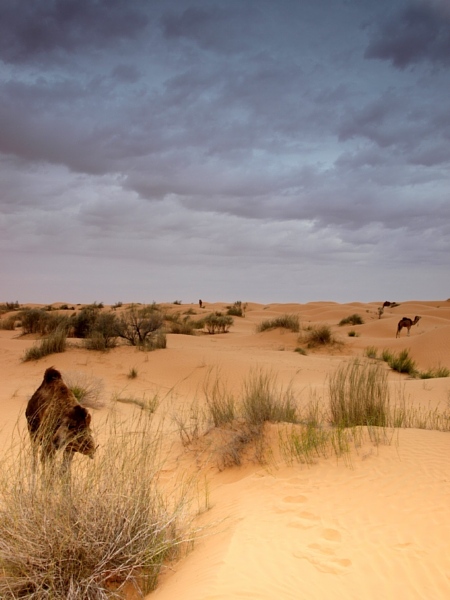
"Dramatic skies with the Cokin ND Grad P series filter "
|
|
The ZD 7-14mm was used fairly frequently (about 25-30 %) of all shots. I do not consider it a "specialist lens" at all. It is a wonderful UWA. It doesn't allow using a filter, but my feeling is that it seldom needs one.
To a large extent, I used the ZD 7-14mm as any normal lens for any subject. Distortion is so perfectly corrected that you can get normal-looking results without much effort. Use this lens while sitting around an early morning campfire, and the resulting photograph takes you right back to those memories. It literally shows the whole scene, including the guys next to you (and your own feet if you don't pay attention, or like that idea).
Used on landscapes, the ZD 7-14mm yields results from which you can crop what I call "instant panoramas". Those are very useful in all situations where you want to get that sweeping vista, while using a tripod for stitching a panorama is no viable option.
|

"Instant panorama, cropped from a 7mm ultra wide angle shot "
|
|
Indeed, there was no way to take a real tripod on this trip. Because I had some uses in mind, I did take a Joby Gorillapod SLR Zoom (attached to one of the Slingshot's straps), and also the RMC-1 remote control. The Gorillapod is fun and versatile, but on this trip I hardly used it (it did draw attention and I had to explain its use often, but that was not what I had in mind). So without exception, all shots in this report and the accompanying slideshow are handheld.
I used the Gorillapod only once actually, in the middle of the first night in base camp, for a 15 sec exposure. That shot didn't work out well. With yellowish cast and blown camp lights, the whole thing only gave an impression of being a satellite picture of a terrorist training camp from a Tom Clancy novel.
The least used lens was the ZD 40-150mm (old version kit lens). I am sure I used it for less than 1 % of all shots. Looking back over my results, I almost wish I had used it more, because the shots I did make with it, are fairly good. Using telephoto allowed for a nice compression of rows of dunes in the frame, to give just one example. But I was afraid of dust attacking that non-weatherproof lens, so I used it sparingly.
For a next trip, I guess I will have to take the ZD 50-200mm (but I will have to buy it first). On the other hand, the ZD 50-200 mm wouldn't have fitted in my bag with all the rest, while the ZD 40-150mm fitted nicely next to all the rest.
One of my favourite lenses in everyday use, is the ZD 50mm f2.0 macro. This is a stellar lens. On this trip, it was used for about 10 % of all shots. I had wanted to try my hand at desert macros, but no real opportunities presented themselves, and our walking pace didn't allow for the concentration necessary for macro work. In the evening, light was too poor.
The main use of the ZD 50mm was thus as a great portrait lens, often in the golden hour before sunrise or right after sunset.
|
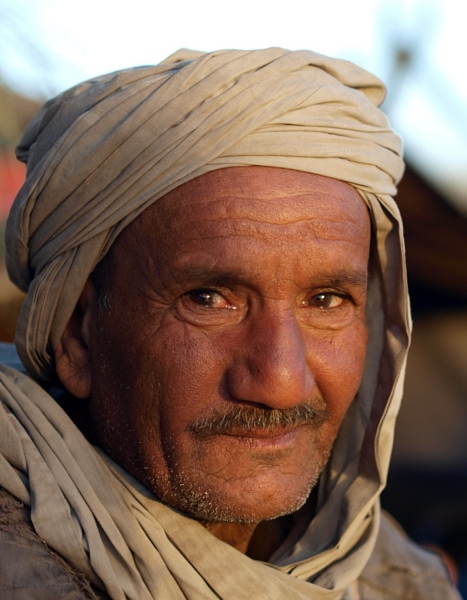
"Early morning portrait of a whole series, included in the slideshow "
|
|
Since my wife and I are pretty open people, we (and some others) really managed to make contact with the local crew, across all language barriers, singing songs and playing games around the campfire etc.
Usually I was up first of our group (around 6.00 AM), and then I joined the crew around the fire where they were baking bread in the embers while waiting for sunrise at 7.15 AM. That allowed me to bond with them and ask them to pose for real portraits on the final day. We did that in the pre-sunrise light, and in the intimacy of the "kitchen area? in the sand, with no other travellers around. With some of these guys I went really close with the ZD 50mm. They made a serious face, and burst out with laughter when they thought I had finished. In return I let them handle my E-3 to make my portrait while wearing their bournous, which made them smile even bigger.
Almost all portraits and pictures of camp-activity included in the slideshow are shot in very early morning light (before or around the actual sunrise) with ZD 50mm or ZD 14-54mm.
|
|


